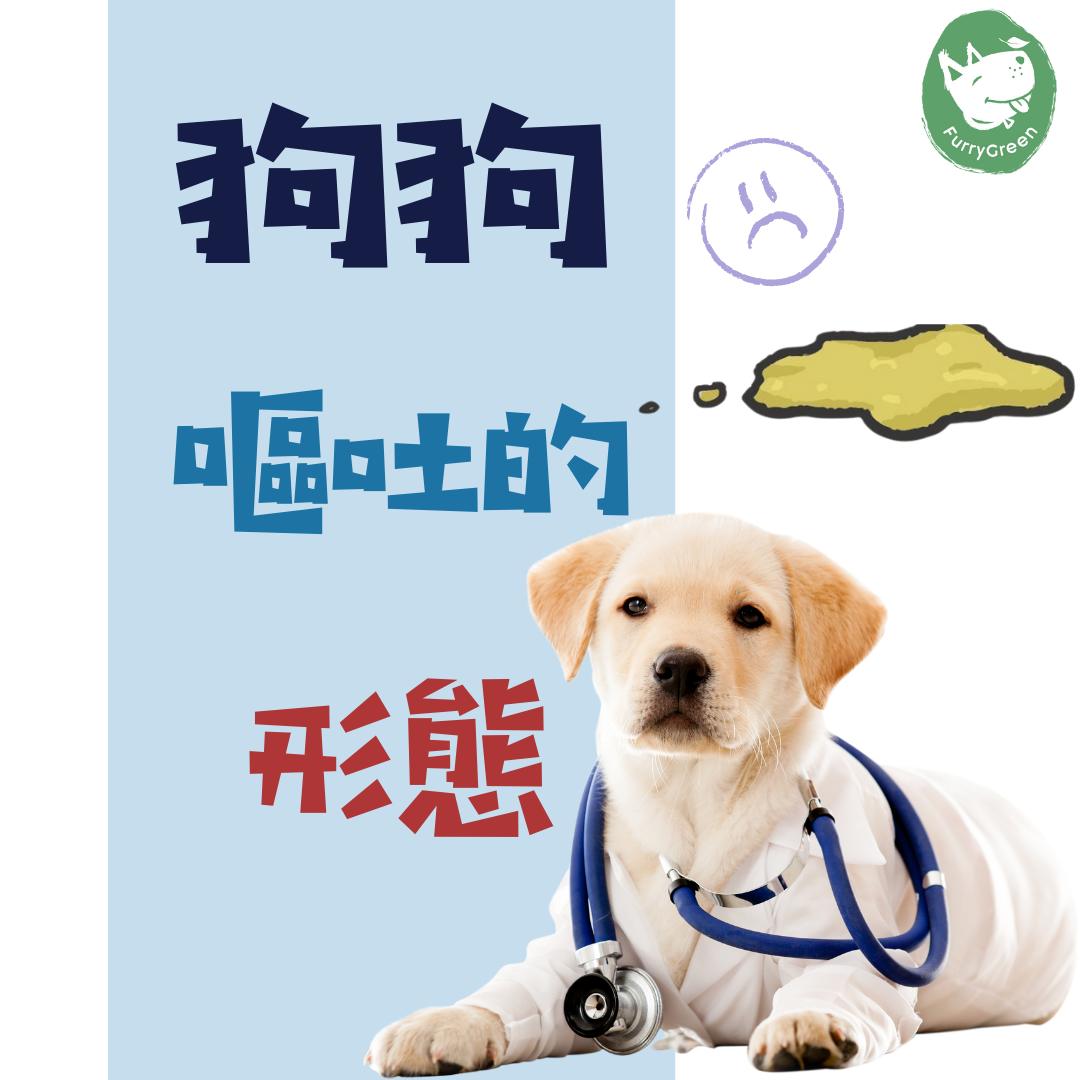
When to Worry About Dog Vomiting
Share
Dog Vomit Color Guide: When to Worry
A guide for pet parents in Hong Kong.
Jump to Quick Reference Guide ⬇️Vomiting in dogs is common, and not every episode is a reason to panic. Dogs may vomit after eating too quickly, from mild stomach upset, or even during car rides. However, in some cases, vomiting can signal a serious health problem requiring immediate veterinary care.
This guide will help you understand the different types of dog vomit, recognize when to be concerned, and know what steps to take next.
Vomiting vs. Regurgitation: Know the Difference
Before diving in, it’s important to distinguish:
- Vomiting: Active process with retching, abdominal effort, and often bile or digested food.
- Regurgitation: Passive bringing up of undigested food or fluid, often soon after eating, without effort.
👉 Causes are very different, so when you talk to your veterinarian, noting which process you saw is very helpful.
What Different Types of Vomit May Mean

1. Undigested Food
- Often due to eating too quickly, overeating, or mild indigestion.
- Can also indicate esophageal disease if regurgitation is involved.
What to do: If your dog is otherwise normal, you can withhold food for 6-12 hours, then offer a small bland meal. If it repeats, see your vet.

2. White or Transparent Liquid with Foam
- Usually stomach acid, seen with mild gastritis.
- Can also be linked to gastric ulcers.
- Rarely, can signal life-threatening bloat (GDV) in large breeds if accompanied by restlessness, bloated belly, or unproductive retching.
What to do: If it happens once, monitor. If repeated or paired with other symptoms, see your vet right away.
3. Yellow or Green Vomit (Bile)
Bile reflux, often from prolonged fasting or irregular feeding.
Can also indicate pancreatitis, intestinal disease, or obstruction.
What to do: If occasional and your dog is bright, feed smaller, more frequent meals. If persistent, consult your vet.

4. Vomiting with Parasites
Worms or other parasites in vomit suggest an intestinal infection.
What to do: Visit your veterinarian for diagnosis and deworming. Regular parasite prevention is especially important in Hong Kong.

5. Blood or Bloodstains
Streaks of blood may come from irritation in the stomach or esophagus.
Causes include ulcers, trauma, tumors, or clotting disorders.
What to do: Any blood in vomit is serious and requires immediate veterinary attention.

6. Dark Brown or “Coffee Ground” Vomit
Suggests digested blood, often from stomach or duodenal bleeding.
What to do: This is an urgent medical emergency. See your veterinarian immediately.

7. Bright Red Vomit
Indicates fresh, active bleeding, often from the stomach or esophagus.
What to do: Treat as a critical emergency. Go to a veterinary clinic immediately.
Is Your Dog a Picky Eater or Have a Sensitive Stomach?
Furry Green's fresh, human-grade pet food is gently cooked to be highly digestible and delicious. Support your dog's gut health with a balanced, natural diet.
Explore Our Fresh FoodDog Vomiting: Quick Reference Guide for Pet Parents in Hong Kong
👉 Save this chart for quick reference.
(For general guidance only. Always consult your veterinarian if concerned.)
✅ Mild or Sometimes Normal
Undigested Food
🍗 Cause: Eating too fast, overeating, or mild indigestion.
🟢 Action: Monitor, slow down eating, small bland meals.
Yellow/Green (Bile)
🟨 Cause: Empty stomach, irregular feeding.
🟢 Action: Feed smaller, frequent meals. If frequent → Vet check.
White Foam / Clear Liquid
⚪ Cause: Stomach acid, mild gastritis.
🟡 Action: Monitor if once. If repeated, especially with restlessness or bloating → Vet urgently.
⚠️ Concerning -- Vet Check Needed
Parasites in Vomit
🪱 Cause: Intestinal worms.
🔶 Action: Veterinary exam and deworming.
Blood Streaks / Pinkish Vomit
❤️ Cause: Stomach irritation, ulcers, trauma.
🔶 Action: Veterinary care recommended -- could worsen.
🚨 Emergency -- Seek Vet Immediately
Dark Brown / Coffee Grounds
☕ Cause: Digested blood (stomach or intestinal bleeding).
🔴 Action: Emergency vet visit.
Bright Red Vomit
🟥 Cause: Active bleeding (stomach, esophagus, or severe injury).
🔴 Action: Emergency vet visit.
Red Flag Signs: When Vomiting Is an Emergency
Seek veterinary help immediately if your dog shows:
Vomiting more than 3 times in 24 hours
Vomit containing blood, foreign objects, or dark brown/coffee ground material
Severe lethargy, collapse, bloated or painful abdomen
Vomiting plus diarrhea, especially if bloody
Vomiting in very young puppies, toy breeds, or elderly dogs (higher dehydration risk)
Local Considerations for Dogs in Hong Kong
Dietary indiscretion: Dogs may scavenge street food, bones, or garbage during walks.
Parasites: Still a risk if dogs are not on year-round prevention.
Heat stress: Hot, humid summers can cause dehydration and GI upset.
Household toxins: Cleaning agents, pesticides, and human medicines are common causes of poisoning.
Safe At-Home Monitoring (for mild cases only)
If vomiting is mild and your dog is otherwise bright:
Withhold food for 6-12 hours (not water).
Offer small amounts of bland food (boiled chicken and rice) before resuming the regular diet.
Provide fresh water, or ice cubes for dogs that gulp.
Monitor closely for red flag signs.
⚠️ Do NOT give human anti-vomiting medications. Many are toxic to dogs.
Frequently Asked Questions
My dog vomits yellow bile in the morning -- is this serious?
Occasional morning bile vomit may be due to an empty stomach. Feeding a small snack late at night often helps. If frequent, it may signal gastritis or another GI issue -- a vet visit is recommended.
Can stress or car rides cause vomiting?
Yes. Motion sickness and anxiety commonly cause one-off vomiting. If your dog vomits often during travel, ask your vet about preventive medications.
When should I deworm my dog to prevent vomiting with parasites?
All dogs in Hong Kong should be on regular year-round parasite prevention, as intestinal worms remain common. Your vet can recommend the best schedule.
Conclusion
Vomiting in dogs has many possible causes -- from something as simple as eating too quickly, to serious conditions like ulcers, toxins, or GI obstruction.
👉 The key takeaway:
Occasional, mild vomiting may be monitored at home.
Persistent, severe, or bloody vomiting is always an emergency.
When in doubt, it’s safest to call your veterinarian. Early treatment can save your dog’s life.
References
Merck Veterinary Manual: Vomiting in Small Animals
Washabau RJ, Day MJ. Canine and Feline Gastroenterology. Saunders Elsevier, 2012.
Willard MD, Twedt DC. Gastrointestinal disorders. In: Ettinger SJ, Feldman EC, eds. Textbook of Veterinary Internal Medicine, 8th ed. Elsevier, 2017.
eClinPath: Gastrointestinal Disorders
WSAVA Global Nutrition & Gastroenterology Guidelines, 2021.
